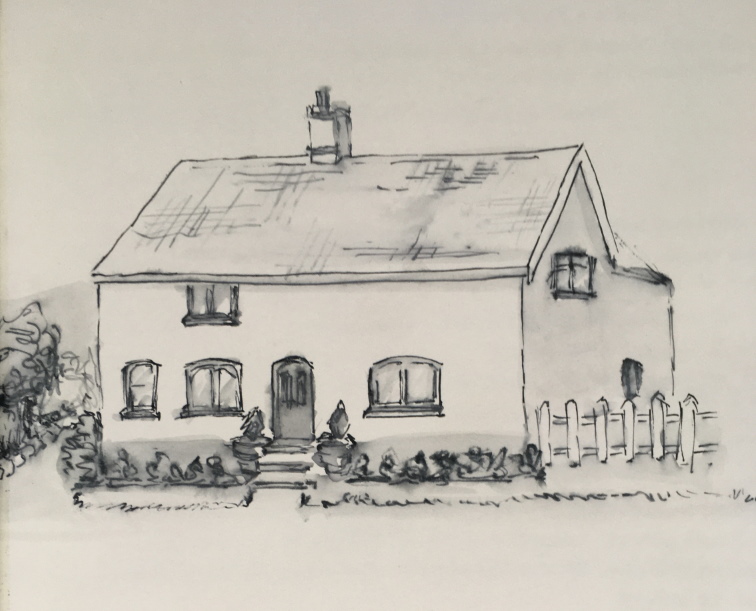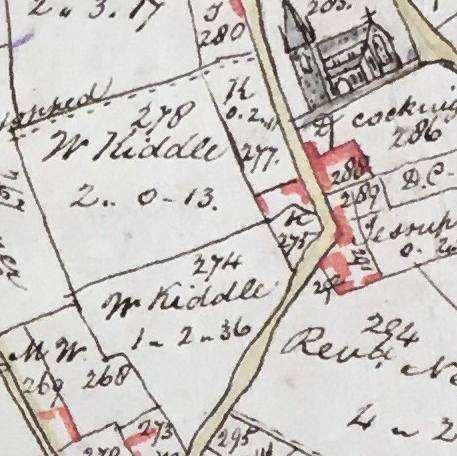
Islay House. Courtesy of Charles Mason
‘The Buildings of England Norfolk 2: North West and South‘ describes Islay House as ‘A very typical timber-framed cottage with lath and plaster infill built in the mid C17 and given a brick skin in the late C18‘.
The house had the most common house-plan used in this country from the seventeenth to the nineteenth century.
A Grade II Listed Building, Islay House (now known as Orchard Cottage) is also one of the oldest buildings in the village of Great Ellingham.
Perhaps the house was built during the time of the Lord Protector, William Cromwell (1649-1660), or maybe a little later, when the monarchy was restored with King Charles II (1660-1685).
Whatever the exact date, around this time, Ellingham Hall (another of the wonderful old properties the village is fortunate to still have) was occupied by Sir Roger Potts, his wife Mary and their children. Worsted weaver, Anthony Beales, may have been living and working in the village. He sold his windmill standing in West Field (which he had purchased two years earlier from Ann Littleproud), to baker John Browne in 1685. Other familiar family names to Great Ellingham appearing in the parish registers around this period include Warren, Turner, Carter, Nuby, Lincoln, Wright, Harvey, Barnard.
Like many of the homes which have stood the test of time, Islay House will have seen the comings and goings of various occupants over the centuries, and witnessed so many social, economic and cultural changes in the lives of the inhabitants.
Given that it is only in relatively recent times that we have become a nation of home owners and occupiers, the families occupying Islay House were not always the owners.
William Kiddle
A Statement of Claims in connection with the Great Ellingham Inclosure (c.1799), captures the claim at No.18 by William Kiddle. He claimed: One Messuage, One Messuage wasted, and 13 acres of land occupied by himself.
Of this property and land, a piece of land containing one acre and one rood was copyhold to Ellingham Hall, the wasted Messuage (I assume here that ‘wasted’ means unused and/or dilapidated) and two roods of land was copyhold of Ellingham Rectory, and two acres of land copyhold of Bury Hall. Along with other Great Ellingham property owners, William Kiddle also claimed various rights on the commons and waste lands of Great Ellingham, rights of cutting and taking firing, and sand and clay for repairs.

Extract from 1802 Map of Great Ellingham. Original held at Norfolk Record Office. Russell James Colman Plans.
Cat. Ref. C/Ca 1/84. With kind permission of NRO
The Particulars & Valuation of the parish of Great Ellingham as taken by the Commissioners for the purpose of inclosing the commons, common fields and waste lands in the village in the year 1800, also provides a snapshot of land owners and occupiers in Great Ellingham at that time.
William Kiddle is again listed as owning and occupying a ‘house, barn, stable, yard and garden‘ with an adjacent garden and orchard, said to be numbered 276, 275 and 277 ‘in the plan‘.
The above extract from an 1802 plan said to refer to the ‘Award’, shows the garden numbered 275 and the orchard 277, either side of what I assume to be 276, the house, barn, stable, yard and garden. This clearly identifies Islay House.
In addition to other land in the village, William Kiddle also owned two adjacent parcels of land, each referred to as ‘Two Acres’ in the Valuation, and numbered 274 and 278 on the plan. Altogether the land owned and occupied by William Kiddle in Great Ellingham (including the house) amounted to 16 acres, two roods and 22 perches.
Thomas Warren
Around 20 years later, a Particular Survey of Great Ellingham 1817-1819, shows that the same house, barn, stable, yard, garden and orchard together with the additional garden land, and the two parcels of land each referred to as ‘Two Acres’, was then owned (and occupied) by Thomas Warren. Thomas Warren was the son-in-law of William Kiddle.
The original page of the document shows amendments: The owner’s name originally written as ‘Widow Kiddle‘ had been crossed out and the name ‘Thomas Warren’ added, with the occupier’s name as ‘Thos. Warren’ remaining unchanged.
A schedule of Great Ellingham Estates prepared in connection with titheable lands (c.1840), shows Thomas Warren as the owner and occupier of the same house and land as mentioned in the Survey of 1817-1819. In addition, Thomas Warren owned and occupied an allotment on Pennell Common. A later comment on the schedule suggests that the house and land was at some point occupied by Benjamin Buck.
Henry Pettitt
In 1845, Islay House was sold.
A Notice advertising an Auction at the Crown Inn, Great Ellingham on 22nd September, 1845, of ‘A Farm-house with suitable outbuildings and several inclosures of very rich and productive arable land, containing altogether 18 acres more or less‘ appeared in the Norwich Mercury of September 6th, 1845. The property was said to be ‘desirably situated in the centre of the town‘ and that it would be divided into several lots. Further, the premises were then in the occupation of Mr William Downes who had been given notice to quit at Michaelmas.
A further Notice in connection with the same premises appeared in the Norwich Mercury on the 13th September, 1845. This time, the Notice set out the property and land being sold in ten lots.
Lot 1 was listed as ‘A convenient and substantially built farm-house with barn, stable and requisite outbuildings, a cottage and well-planted orchard and garden‘ which was ‘very pleasantly situated near the church‘. The Notice also stated that of the premises in this lot, a house and two roods of land are copyhold of the Manor of Ellingham Rectory with the residue being freehold.
Again, the Notice stated that all the premises referred to in the ten lots were then occupied by William Downes or his under-tenants.
At the Auction at the Crown Inn on 22nd September, 1845, local farmer and land owner, Benjamin Barnard, purchased an inclosure of one acre three roods and sixteen perches of arable land. The inclosure, referred to as ‘Clay Pit Close’, abutted upon lands which he (Benjamin Barnard) already owned.
Claypit Close was conveyed to Benjamin Barnard by a Deed dated 20th December, 1845. The parties to the Deed were Thomas Warren, a farmer late of Great Ellingham but now a gentleman of the City of Norwich, William Kiddle Warren, late of Roydon but now of the City of Norwich and described as a yeoman, the purchaser Benjamin Barnard, a farmer of Rockland All Saints, Charles Cockell a gentleman of Attleburgh and shoemaker Henry Pettitt of Hockham.
The Deed also confirmed that Henry Pettitt of Hockham was the largest purchaser of the property described in the lots numbered 1 to 10 at the Auction on 22nd September. As the purchaser of the majority of the property, Henry Pettitt would have been given certain original deeds on the completion of his purchase. In the Deed concerning Benjamin Barnard’s purchase of Clay Pit Close, Henry Pettitt joined in the Deed to covenant (promise) with Benjamin Barnard to keep certain earlier deeds in his safe custody, and to provide copies if asked to do so.
Accordingly from 1845, I believe Islay House was in the ownership of Henry Pettit. However, I do not believe that Henry Pettitt occupied the property as the 1851 census finds 44 year old shoemaker Henry Pettitt with his wife Mary Ann and 11 year old son, Arthur H living in Hockham.
On the 11th September, 1851, Henry Pettitt died, and was buried at Great Hockham a few days later. This may well have brought the Pettitt’s ownership of Islay House to a close.
Arthur Henry Pettitt
However, the Electoral Register for 1863 reveals Henry’s son, Arthur Henry Pettitt of Hockham, as the owner of a freehold and copyhold house and land in Church Street, Great Ellingham.
32 years later, the 1895 Register of Electors lists Arthur Henry Pettitt (now of Ovington), as still owning freehold and copyhold house and land in Church Road, Great Ellingham.
Arthur Henry Pettitt, then of Josephine, Laindon Hills, Essex died on the 13th October, 1911. In his Will dated 5th August, 1911, he gave ‘all my right and interest in the Norfolk property‘ to ‘my younger son‘ and said that he hoped that his younger son would keep it to his profit. I cannot be certain whether Arthur Henry Pettitt still owned Islay House at the time of his death. It is, of course, possible that Arthur Pettitt sold the property and purchased a replacement investment property in Great Ellingham.
However, what I can say is that it appears that the Pettitt family owned Islay House for certainly upwards of 50 years, and likely the house was tenanted throughout that period.

Church Street also known as the Street. Islay House on the right. Ye Olde Thatche Shoppe on left and the Crown Public House in the background.
Postcard Carol Ewin
Sources:
Pevsner, Nikolaus & Wilson, Bill. 1962. The Buildings of England Norfolk 2: North West and South. 1999 Edition. ISBN 0140710604.
1800 Inclosure Commissioner’s Particulars and Valuation. Norfolk Record Office. Catalogue Ref: MC2213/119
1799-1842 F W Horner, Records of the Surveyors to Commissioners for Inclosures in Parishes in Norfolk and Suffolk. Great Ellingham (Act 1799). Norfolk Record Office. Catalogue Ref: BR 90/2
1802 Russell James Colman Plans. Great Ellingham. Norfolk Record Office. Catalogue Ref: C/Ca 1/84
Norwich Mercury September 6th, 1845 & 13th September 1845
Conveyance Deed dated 20th December, 1845. Bury Hall Deeds Collection. Emma Wilson.
1851 census HO107/1823/228
Great Hockham, Monumental Inscriptions 1647-2003. Norfolk Family History Society. https://www.norfolkfhs.org.uk/ Accessed 08/07/2020
“England, Norfolk Register of Electors, 1832-1915,” database with images, FamilySearch (https://familysearch.org/ark:/61903/3:1:S3HY-DRN6-BR?cc=1824705&wc=MX6S-RZ9%3A161034801%2C161988401%2C161042501 : 21 May 2014), Norfolk > Western division > 1847 > image 65 of 73; Record Office, Central Library, Norwich.
“England, Norfolk Register of Electors, 1832-1915,” database with images, FamilySearch (https://familysearch.org/ark:/61903/3:1:S3HT-D1LQ-RL5?cc=1824705&wc=MX6S-R38%3A161034801%2C161988401%2C161058401 : 21 May 2014), Norfolk > Western division > 1863 > image 99 of 113; Record Office, Central Library, Norwich.
Will of Arthur Henry Pettitt dated 5th August, 1911 obtained and downloaded from https://www.gov.uk/search-will-probate 13.07.2020